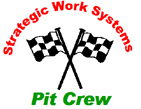Could email be hurting your preventive maintenance programs?
Working with many different types of manufacturing facilities seeking improvement programs around North America proves to be very insightful. We have been working with several locations to improve communications about equipment and process reliability and have discovered why some preventive maintenance programs fail. The answer: e-mail. Here’s a scenario.
For several years now, e-mail has grown rapidly as a communications tool in XYZ Company. At one location, they are well into a two-year planned, preventive, and Total Productive Maintenance implementation process. We were asked to help answer the question, “How can we improve communications so that plant reliability and performance will improve?”
Communications methods at this plant typically include large and small meetings, one-on-one discussions, signs and posters, a plant newsletter, and e-mail. The most common communications method was e-mail, hands down. Everyone we met with spoke of e-mail’s virtues: speed, ease of mass distribution, ease of getting a reply, and the ability to save time by not having to arrange meetings to communicate about specific topics.
So what was the downside of e-mail in this plant? Initially, there was little awareness of any limitations. But the closer we got to the people on the plant floor–maintenance, operations, supervision–the more we saw a completely different side of e-mail. Nearly 70 percent of employees did not have access to e-mail. (This was the plant floor group!) And even if they did have access, about 30 percent of the workforce could not read or write above the 7th grade level, which is the level of basic adult literacy. Of the 70 percent that had access to e-mail, few had sufficient computer skills, and most was related to games on a home computer.
So the question became, “How can we bridge this e-mail communications gap?” First of all, supervisors should be accountable for reading and printing e-mails that are relevant to their work group and seeing that the messages are communicated to everyone who needs to know. You can imagine how many e-mails are distributed daily at this plant. And you can imagine how little time the supervisors have to spend reading all those e-mails looking for items that should be communicated to their work groups. Supervisors told us, “There has to be a better way.”
To address these concerns, we looked at a number of critical communications that went out via e-mail, and we found some dysfunctional features:
- The subject line told little of the message’s importance.
- The opening paragraph did not summarize what the message was but rather began building the reader up to learn more as he or she read on.
- The text of the message was typically written at the 12th grade level and higher in very long lines of text and paragraphs.
- The last line tended to be, “Make sure this subject gets communicated to those employees in your area who do not have e-mail access.”
So what is the bottom line for improving communications in ways that lead to improved plant reliability and performance?
- Don’t assume that just because you sent an e-mail that you have communicated. Chances are you have not communicated at all to the very people who need to understand the message. Make sure there is a formal communications structure in place to bridge the gap between those who have e-mail access and those who do not.
- Write e-mails that speak to the readers’ reading and writing levels.
- Make the subject line a specific action statement.
- Specify who needs to hear this message in the opening paragraph. The lead paragraph should be a very brief summary of the entire e-mail message.
- Use short sentences, bullet lists, and specific action statements whenever possible. Do not ramble.
Oddly enough, we have noticed many of the same barriers to effective PM programs as with email. Many PMs are not understood and are not used as intended because they do not communicate to the end user as effectively as they should. Following many of the same guidelines for e-mail effectiveness will likely result in more effective PMs in your plant. In the information age, communications will be a fundamental, underlying key to plant and equipment reliability.
© 1998
Robert M. Williamson
Strategic Work Systems, Inc.
Columbus, NC 28722
[email protected]
![]() Download a PDF of this article by clicking here Communication Tools
Download a PDF of this article by clicking here Communication Tools
